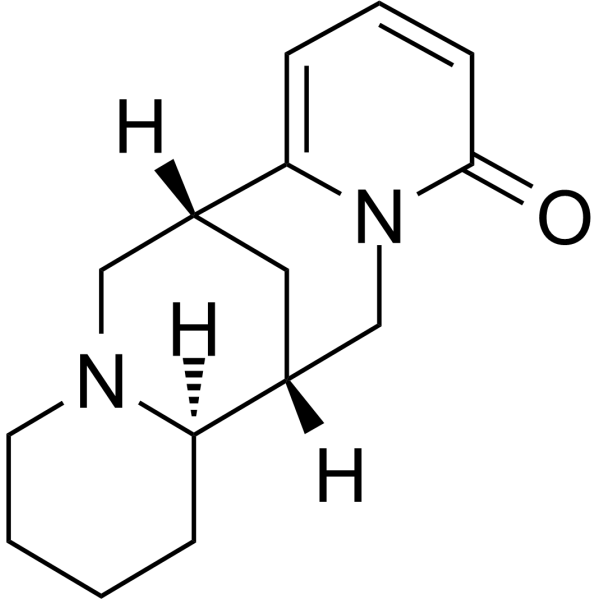上海金畔生物科技有限公司为生命科学和医药研发人员提供生物活性分子抑制剂、激动剂、特异性抑制剂、化合物库、重组蛋白、同位素标记物,专注于信号通路和疾病研究领域。
Anagyrine (Synonyms: (-)-Anagyrine; Monolupine; Rhombinine) 纯度: 97.05%
Anagyrine ((-)-Anagyrine) 是一种存在于 Lupinus albus 中的喹啉类生物碱。Anagyrine 可与毒蕈碱和烟碱乙酰胆碱受体 (AChR) 结合,IC50 值分别为 132 和 2096 µM。Anagyrine 是一种有效的 nAChR 脱敏剂,Anagyrine 可以直接脱敏 nAChR,不需要代谢。

Anagyrine Chemical Structure
CAS No. : 486-89-5
| 规格 | 价格 | 是否有货 | 数量 |
|---|---|---|---|
| 1 mg | ¥1400 | In-stock | |
| 5 mg | ¥4100 | 询价 | |
| 10 mg | 询价 | ||
| 50 mg | 询价 |
* Please select Quantity before adding items.
| 生物活性 |
Anagyrine ((-)-Anagyrine) is a quinolizidine alkaloid that has been found in Lupinus albus. Anagyrine binds to muscarinic and nicotinic acetylcholine receptors with IC50 values of 132 and 2096 µM respectively. Anagyrine is a potent and effective desensitizer of nAChR, and Anagyrine can directly, without metabolism, desensitize nAChR[1][2][3]. |
||||||||||||
|---|---|---|---|---|---|---|---|---|---|---|---|---|---|
| 体外研究 (In Vitro) |
|||||||||||||
| 分子量 |
244.33 |
||||||||||||
| Formula |
C15H20N2O |
||||||||||||
| CAS 号 |
486-89-5 |
||||||||||||
| 性状 |
油状物 |
||||||||||||
| 颜色 |
Colorless to light yellow |
||||||||||||
| 结构分类 |
|
||||||||||||
| 初始来源 |
|
||||||||||||
| 运输条件 |
Room temperature in continental US; may vary elsewhere. |
||||||||||||
| 储存方式 |
4°C, protect from light *In solvent : -80°C, 6 months; -20°C, 1 month (protect from light) |
||||||||||||
| 溶解性数据 |
In Vitro:
H2O 中的溶解度 : 25 mg/mL (102.32 mM; 超声助溶) DMSO 中的溶解度 : 25 mg/mL (102.32 mM; 超声助溶; 吸湿的 DMSO 对产品的溶解度有显著影响,请使用新开封的 DMSO) 配制储备液
查看完整储备液配制表
* 请根据产品在不同溶剂中的溶解度选择合适的溶剂配制储备液;一旦配成溶液,请分装保存,避免反复冻融造成的产品失效。 * 备注:如您选择水作为储备液,请稀释至工作液后,再用 0.22 μm 的滤膜过滤除菌后使用。
Mass (g) = Concentration (mol/L) × Volume (L) × Molecular Weight (g/mol)
Concentration (start) × Volume (start) = Concentration (final) × Volume (final) This equation is commonly abbreviated as: C1V1 = C2V2
In Vivo:
请根据您的 实验动物和给药方式 选择适当的溶解方案。 以下溶解方案都请先按照 In Vitro 方式配制澄清的储备液,再依次添加助溶剂:
动物溶解方案计算器
请输入动物实验的基本信息:
给药剂量 mg/kg 动物的平均体重 g 每只动物的给药体积 μL 动物数量 只 由于实验过程有损耗,建议您多配一只动物的量
计算结果
工作液所需浓度 : mg/mL
该产品水溶性佳,请具体参考实测 水 / PBS / Saline 中的溶解度数据。
免费服务热线:021-50837765
E-mail:sales@jinpanbio.com 技术支持电话:021-50837765 技术支持邮箱:sales@jinpanbio.com |
||||||||||||
| 纯度 & 产品资料 |
纯度: 97.05%
Data Sheet (624 KB) SDS (252 KB)
COA (199 KB) HNMR (203 KB) RP-HPLC (73 KB) MS (70 KB) 产品使用指南 (1538 KB) |
||||||||||||
| 参考文献 |
|
所有产品仅用作科学研究或药证申报,我们不为任何个人用途提供产品和服务
